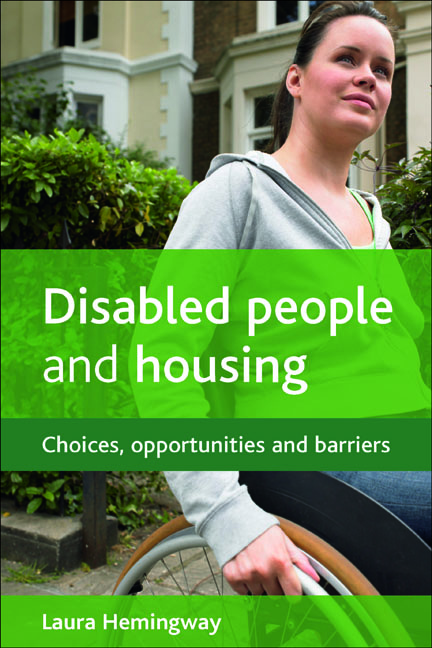Book contents
- Frontmatter
- Dedication
- Contents
- Acknowledgements
- one Introduction
- two Housing policy and disabled people: from past to present
- three Understanding disability: from ‘personal tragedy’ to social disadvantage
- four Physical and communication barriers: the built environment and access to information
- five Financial considerations: income, affordability and risk assessment
- six Attitudinal constraints: assumptions and institutional practices
- seven Creating the ‘home’ in a society of barriers
- References
- Websites
- Index
two - Housing policy and disabled people: from past to present
Published online by Cambridge University Press: 07 September 2022
- Frontmatter
- Dedication
- Contents
- Acknowledgements
- one Introduction
- two Housing policy and disabled people: from past to present
- three Understanding disability: from ‘personal tragedy’ to social disadvantage
- four Physical and communication barriers: the built environment and access to information
- five Financial considerations: income, affordability and risk assessment
- six Attitudinal constraints: assumptions and institutional practices
- seven Creating the ‘home’ in a society of barriers
- References
- Websites
- Index
Summary
Housing for disabled people has historically been provided via a variety of institutional forms of accommodation. Since the 1960s, however, coinciding with the emergence of the American Independent Living Movement (ILM), it has been argued that if inclusion and ‘independent living’ are to be achieved, disabled people must have the right to self-managed accessible housing. There have been several pieces of legislation that have had an impact on housing rights, entitlements and provision for disabled people in some way, whether for home support services for everyday living, for physical needs such as adaptations, or more broadly for housing tenure options. There have also been various providers of housing, including local authorities, social services departments, housing associations and private sector developers. This chapter offers an overview of some of the main developments in housing policy, regulation and official advice as it relates to disabled people, with the aim of highlighting the extent of progress towards better practices. This is not a definitive guide to policy and legislation; there is not the space here to offer the kind of detail that such an account would entail. The aim, instead, is to highlight important markers in housing policy history for disabled people.
We look back over the past century, from the 1900s to the present day, before providing a timeline of key events. We then consider future possibilities in light of the change of government in 2010, before reviewing some examples of international good practice. A key objective of the chapter is to underline the importance of understandings of disability for policymakers and service providers. Housing policy and provision for disabled people are affected by the availability and distribution of resources; the management of allocation processes and agencies responsible for provision; and the perceptions of disability held at both individual and institutional levels. This chapter aims to emphasise the significance of the latter. At a broad level, for instance, associations of disability with ideas of dependency, suffering or medical concerns have been built into the operations and regulations of institutions and agencies.
- Type
- Chapter
- Information
- Disabled People and HousingChoices, Opportunities and Barriers, pp. 19 - 50Publisher: Bristol University PressPrint publication year: 2011

